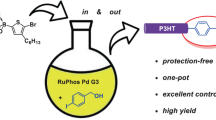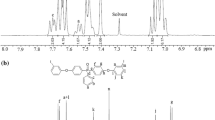Summary
The π-allylnickel-catalyzed living coordination polymerization of methylallene gave polymers with predictable molecular weight and narrow molecular weight distribution in high yields. The polymers possessing various microstructural units (i.e., the ratio of the 1,2- and the 2,3-polymerizations), produced by varying the nature of the catalyst and the solvents, were subjected to the hydroboration with borane reagents such as borane tetrahydrofuran complex (BH3•THF) and 9-borabicyclo[3.3.1]nonane (9-BBN). Subsequent oxidation gave poly(alcohol)s whose hydroxy-content could be varied by the borane reagents used. For example, the quantitative conversion of the double bonds in poly(methylallene) into the hydroxy group was attained by the hydroboration using an excess amount of BH3•THF. Thermal properties of poly(alcohol)s were found to be dependent upon the microstructure and the hydroxy-content of the polymers.
Similar content being viewed by others
References and Notes
For the reviews, see for example: (a) Pinazzi C, Brosse JC, Pleurdeau A, Reyx D (1975) Appl Polym Symp 26:73 (b) Schulz DN, Turner SR (1982) Rubber Chem 55:809 (c) McGrath MP, Sall ED, Tremont SJ (1995) Chem Rev 95:381
Chung TC, Raate M, Berluche E, Schulz DN (1988) Macromolecules 21:1903
(a) Finch CA (1992) Polyvinyl Alcohol Developments. Wiley, New York (b) Andrade JD (1976) Hydrogels for Medical and Related Applications. ACS Symp Ser vol 31. American Chemical Society, Washington DC (c) Ramakrishnan S (1991) Macromolecules 24:3753 (d) Lagaron JM, Powell AK Bonner G (2001) Polym Testing 20:569 (e) Lagaron JM, Catala R, Gavara R (2004) Mat Sci Tech 20:1
(a) Tomita I, Kondo Y, Takagi K, Endo T (1994) Macromolecules 27:4413 (b) Tomita I, Kondo Y, Takagi K, Endo T (1995) Acta Polymer 46:432 (c) Takagi K, Tomita I, Nakamura Y, Endo T (1998) Macromolecules 31:2779 (d) Takagi K, Tomita I, Endo T (1997) Macromolecules 30:7386 (e) Endo T, Takagi K, Tomita I (1997) Tetrahedron 53:15187. (f) Takagi K, Tomita I, Endo T (1997) Chem Lett 1187 (g) Takagi K, Tomita I, Endo T (1998) Macromolecules 31:6741 (h) Tomita I, Ubukata T, Endo T (1998) React Funct Polym 37:27 (i) Taguchi M, Tomita I, Endo T (2000) Angew Chem Int Ed Engl 39:3667 (j) Takagi K, Tomita I, Endo T (2003) Polym Bull 50:335
To demonstrate the possibility of the chemical modification of the double bonds in the poly(allene)s, we described the hydrosilylation reaction of poly(allene) (poly(1,2-propadiene)) to give polymers having silane-coupling units. In this case, the 75% of the exomethylene units (> C=CH2) was silylated under the heating conditions. See, Taguchi M, Tomita I, Endo T (2000) Macromol Chem Phys 201:2322
Dawans F, Marechal JC, Teyssie P (1970) J Organomet Chem 21:259
(a) Ginzburg YI (1940) Gen Chem USSR 10:513 (b) Hennion GF, Sheehan JJ (1949) J Am Chem Soc 71:1964
The microstructure of the polymers from substituted allenes is controllable by the anionic ligands (X), neutral ligands (L), and the polymerization solvents. We would like to report the details in the forth-coming paper.
If the polymer was isolated by precipitation without washing carefully by permeable membrane, the polymer became barely soluble in organic solvents probably by the cross-linking reaction between the hydroxy groups in the polymer and boric acid derivatives.
The hydroboration of both α,α-disubstituted and α,α,β-trisubstituted olefins (e.g., CH2=C(CH3)C2H5 and CH3CH=C(CH3)2, respectively) by BH3•THF is known to give the anti-Markovnikov adducts in more than 98% selectivity. Thus, the present polymer reactions are believed to proceed in an analogous selectivity, resulting in the preferential formation of less substituted alcohol units. See: Brown HC and Zweifel G (1960) J Am Chem Soc 82:4708.
The result obtained here is in good accordance with the fact that α,α-disubstituted olefins are more susceptible than trisubstituted ones to the selective hydroboration reagents such as 9-BBN. See: (a) Brown HC, Liotta R, Scouten CG (1976) J Am Chem Soc 98:5297 (b) Brown HC, Moerikofer AW (1963) J Am Chem Soc 85:2063
Pritchard JG (1970) Poly(vinyl Alcohol) Basic Properties and Uses. Gordon Breach, London
Author information
Authors and Affiliations
Corresponding author
Rights and permissions
About this article
Cite this article
Kino, T., Tomita, I. Synthesis of Poly(alcohol)s by Hydroboration/Oxidation of Poly(methylallene) Prepared by π-Allylnickel-Catalyzed Living Coordination Polymerization. Polym. Bull. 55, 251–258 (2005). https://doi.org/10.1007/s00289-005-0435-9
Received:
Revised:
Accepted:
Published:
Issue Date:
DOI: https://doi.org/10.1007/s00289-005-0435-9




